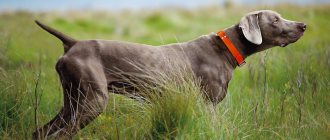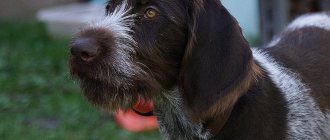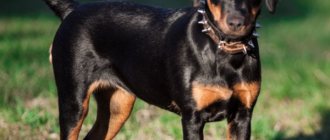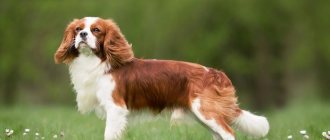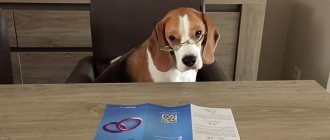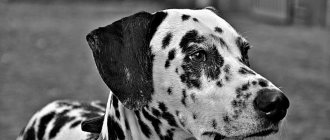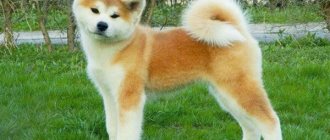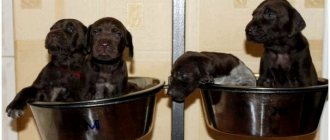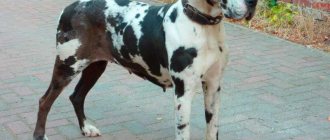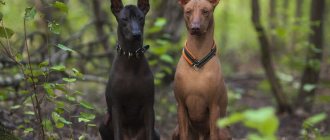Long gone are the days when meat could only be obtained in the forest. Despite this, millions of people eagerly await the opening of the hunting season to once again experience the intoxicating smell of foliage, the excitement of pursuing prey and the triumph of success. The most reliable companion in this purely male occupation, despite all the latest technologies, is a dog.
The choice of a four-legged companion depends on who its future owner is going to hunt. For those who prefer to treat their friends to game they have hunted with their own hands, a shorthaired pointer puppy will be one of the best acquisitions of a lifetime.
Description of the breed
Appearance
Description of the shorthaired pointer breed. Representatives of this breed are large, lean dogs. The maximum height at the withers, according to the standard, is 66 cm. The dog's body is covered with a short, tight-fitting six. Color ranges from pure black to café au lait. It is usually diluted with white spots or tan marks. This allows them to be almost invisible in the grass when hunting. The shorthaired pointer has floppy ears and dark brown eyes.
Shorthaired Pointer puppies boast a very light coat color that darkens over time. The limbs are long, thin, the paw is gathered into a dense “lump”. The chest is well developed.
It is believed that the Shorthaired Pointer is in ideal working condition when the last three ribs are visible. The dog should demonstrate sweeping, confident movements and have a proud posture.
Character and behavioral characteristics
This shaggy hunter is a real fidget. He is interested in everything - both what moves and what simply makes up the interior of the house. With proper upbringing, this breed is not at all prone to aggression.
Anger and unhealthy stubbornness will appear if the shorthaired pointer puppy is left to its own devices and deprived of the owner’s attention.
Surprisingly, these dogs love children very much. You just need to make sure that your four-legged friend, while playing with your baby, doesn’t knock him off his feet in the heat of excitement. For the same reason, it is not recommended for older people to purchase a representative of this breed - they may not be able to cope with this energetic companion.
It can be difficult to make friends with cats and other dogs. His love for dominance and tireless hunting interest sometimes make him simply unbearable for our other smaller brothers. You can keep a dog both in a city apartment and in a private house.
To keep everything safe and sound, you need to take the dog for a good walk and don’t forget to buy toys for him. It should be noted that Shorthaired Pointers are very smart companions. The tailed baby must learn from the first days that no matter how sweet and cunning he is, no one is going to spoil him again.
Rules for training shorthaired pointer to hunt game
After the grown-up Shorthaired Pointer has mastered all the necessary commands and is sufficiently socialized, he can begin to be trained to hunt game. The process will be helped by the fact that these cops have very developed instincts; only when they smell the game, the dog itself will take a stance.
Important! The stance characteristic of shorthaired pointers is that the dog freezes, tense as a string. The body is elongated, the head is raised high, the tail is raised.
The first thing a dog is taught is the correct movement. The animal must learn to follow the owner as he moves in search of prey. Also, the shorthaired pointer must be able to find its owner among the trees and thickets.
Props consisting of feathers and bird carcasses will help teach you how to pick up a scent correctly. The dog needs to be allowed to sniff them and give the command “search”. The animal must find a second carcass hidden in the thickets in advance and bring it to the owner on command.
A dog can be taken out to hunt after it is 8-10 months old. Since shorthaired pointers by their nature are too gambling, impatient and restless, you should only take a pet for hunting that the hunter himself is 100% confident in. The best time of year for the first hunt is spring.
Important! Shorthaired Pointers are very smart and understanding dogs. If the owner cannot cope with upbringing, then the problem is most likely in himself - he lacks either experience or patience. Only a professional dog handler can help you understand the problems and find ways to solve them in such situations.
Source
Training and coaching
Command training
Like any self-respecting dog, the shorthaired pointer must know and unconditionally follow commands from the general training course. Strict discipline is the guarantee that the dog will remain alive and healthy both in the metropolis and in the forest. Raising a Shorthaired Pointer begins from the very moment he appears in the house. The puppy should be given a place where he will not disturb anyone, and bowls for water and food should be provided.
Babies need to go to the toilet much more often than adult animals. If a puddle or “heap” appears on the floor, cruel punishment will not solve anything, but will only embitter the dog.
It is better to take the puppy outside after each feeding or sleep period or place it in a place where he will have a toilet. As soon as he relieves himself, praise and pet him. You should immediately choose a short and sonorous nickname for your dog, which is easy to pronounce and easy to remember.
It is necessary to accustom the young hunter to a collar and leash. You should not allow your child to play with the equipment; it is strictly forbidden to use it for physical punishment.
Beatings and cruel treatment are generally unacceptable - this will make the dog aggressive and uncontrollable.
At the age of 2.5 - 3 months, you can begin to practice such commands as “Nearby”, “Sit”, “Lie down”, “Stand”, “Voice”, “Fetch”. If the owner has a vague idea of how to train a pet, it is better to contact a specialist. It is also important to teach the dog not to pick up anything that seems edible from the ground and not to accept food from the hands of strangers. This will protect her from poisoning and kidnapping.
Character
By nature, the shorthaired pointer is a very curious and cheerful dog. His peculiarity: focus on results and natural passion. At a young age and adolescence, they are curious and interested in literally everything.
Active exploration of the outside world and curiosity can sometimes be a problem, but only at a young age. With age, he becomes obedient, less emotional and more compliant.
The German treats children well and does not show excessive aggression towards strangers. Alertness and accuracy are inherent in him in adulthood.
The problem may arise if small animals, such as cats, live in the house. He is characterized by suppressive behavior, in which he shows that he is the leader. It will not harm the cat, but it will not infringe on its rights. It is enough to stop him several times and indicate that it is impossible to act in this way. The dog obeys perfectly with proper education and training.
Game hunting training and pen stance
For the owner, training a shorthaired pointer does not end after learning the basic commands. His responsibilities also include helping the pet learn how to properly search for prey.
Hunting dogs of the shorthaired pointer breed, obeying genetics, make a stance when they detect a bird. The dog freezes in place, fixes his gaze on the prey, lowers his head, raises his paw, and his usually lowered tail sharply straightens. In this position, the dog looks like an arrow, which will hit the target in a moment.
It’s rare that a dog, once in a field, independently begins to do everything as it should. First you need to teach the dog to move quickly across the field in a “shuttle”. This allows you to cover a larger search area.
The hunter begins to walk quickly in one direction. As soon as the shaggy companion overtakes him, the owner changes direction to the opposite. And so on several times until the dog understands what is required of him. You need to make sure that your four-legged friend does not run too far.
Some dogs get too carried away with searching and even forget about their owner. In this case, the hunter should hide for a while - hide in the grass and not make any sounds. Soon the tailed comrade will get worried and begin to look for the owner. From now on he will closely monitor his companion.
After the pet has learned what a “shuttle” is, it should be taught how to react correctly to found game. This should be done where there is no possibility of meeting a live bird. The carcass should be placed on the ground so that the dog does not notice it. Then place him at some distance and give the command “Search.” When the tailed hunter discovers “game”, the command “Give” is given. After the find is in the hands of the owner, the dog should be praised.
If the training of the Shorthaired Pointer was successful, you can go on a real hunt. The best option for the first time would be May, when the season for swamp game opens. Experts have noted that the dog’s stance on these birds lasts longer.
Sometimes training a shorthaired pointer is complicated by the fact that the dog is impatient and tries to run over the bird. In this case, the hunter should be patient and lead the dog on a leash at first. When you spot prey, you should tighten the leash and hold the dog in this position for several moments. Soon she will understand exactly what is required of her.
Features of training a shorthaired pointer
There are interesting videos on the Internet about hunting with a cop. This is, indeed, a fascinating sight if the dog is properly raised and trained to hunt game. Hunting training should be carried out by an experienced owner who knows training techniques and can teach the pet the necessary skills.
If a Shorthaired Pointer is being raised as a companion, it is important to take into account the characteristics of its temperament and character:
- When training, combine elements of play and training - a short lesson-game-repetition of the lesson. If the baby does something correctly, praise, encourage, and he will repeat the action to bring joy to the owner.
- Stop your puppy from trying to chase cats, chickens and other animals that he sees as potential prey, otherwise his hunting instincts will create many problems.
- When trained at home, by the age of 7-8 months, the Shorthaired Pointer should clearly follow basic commands given by voice and gesture in any environment. You can take a puppy training course (from 3 months), and then an obedience course.
- Constant reprimands and prohibitions lead to rebellion - the dog does not understand the lessons and does not obey. Hard training is not for the Shorthaired Pointer. Give him the opportunity to be a “partner”, to make his own decisions regarding his actions, otherwise the owner will become an enemy.
- Punishment for an offense must be fair and follow immediately after the offence. Choose the method of influence based on the makeup of your pupil’s nervous system. For example, if it is enough to shout at a timid dog, then a balanced, normal shorthaired pointer needs to be shown “who’s boss.” Moreover, this breed is immune to physical influence. Demonstration of psychological superiority will be more effective.
- The Kurzhaar must feel needed by his “pack”. The connection between a pet and your family is felt especially strongly if you have a common goal, for example, agility classes, sledding (in warm weather), general training courses (GTC).
Trainers will help you train shorthaired pointer dogs. Dog trainers will select an individual training program and training methods, taking into account the age, temperament, and character of the pet.
Other articles:
- Fox Terrier is an energetic dog
- Boerboel education and training
Rules of conduct when hunting
There are several rules that must be followed when raising a pet so that it turns out to be a real hunting dog:
- From an early age, all attempts by a dog to hunt domestic animals should be strictly suppressed. Otherwise, during a hunt, there is a high risk that the dog may run away to the nearest populated area to chase chickens or cats.
- During training, the dog should not be allowed to catch insects or dig up mouse holes. Extra sounds and movements will scare the bird away, and the dog will completely lose interest in searching for it.
- The shorthaired pointer must clearly understand that a hunted bird is not a toy. The desire to rip out all her feathers or chew her to an unrecognizable state should be eradicated from the first day of training.
- The dog should be taught to be careful around strangers. It is necessary for the puppy to learn that he has one friend and owner, and not just any person with a gun.
- It is not recommended to let your dog go alone into the forest “just for a walk.” He may get into trouble or be seriously injured.
- The four-legged hunter should be gradually accustomed to the sound of a shot, starting to shoot at a great distance from the dog. This will eliminate the risk of the dog running into the forest in panic as soon as the guns start ringing.
- The Kurzhaar must react calmly to the noise of technology and behave with dignity both in a car and in public transport. This will save the hunter from many problems and keep the dog healthy.
Read also
Training
Training 331Training of service and guard dogs should only be carried out by a specialist. Such training requires special knowledge and extensive experience. An incorrectly or poorly trained service dog can become dangerous not only to others, but also to
Initial training
Initial training It's bad if you are late with the start of classes. If the formation of character has already occurred, then the dog perceives training as violence against the body, it is necessary to break already established character traits. Carefully observing the development and
"KINDERGARTEN" TRAINING
KINDERGARTEN TRAINING Chapter One Introduction to Kindergarten Training Before you begin training your dog, I recommend reading the entire book, not just the section that interests you at the moment. After reading the entire book, you will understand that
4 DOG TRAINING
4 DOG TRAINING Training dog breeders in training includes training theory (information about the physiological basis of dog behavior), training techniques, and practical exercises at the training site. On knowledge of the physiological basis of dog behavior
6 Retriever training
6 Training a retriever When you bring a retriever into your home, try to immediately accustom him to the rules by which he will henceforth have to live. Basics of general training The most important postulate of dog training is constant compliance with the relationship between the animal’s behavior and
Training
Training Training is the development in a dog of certain skills necessary to control its behavior. In this case, the owner encourages the dog with his signals (commands and gestures) to perform (or not perform) certain actions: sitting, laying down, giving
TRAINING
TRAINING Home training of a Shorthaired Pointer involves practicing all the skills necessary to take him out into the field to familiarize himself with the immediate object of the hunt. This also includes working out all the commands for versatile use in the future, as well as
Training
9. Training Training a Caucasian Shepherd is the purposeful formation of the necessary behavior pattern in a dog. After a certain signal, the dog begins to act according to a learned pattern. Physical and mental stress should increase
Training
Training When working with a pig, it is necessary to avoid sudden movements and loud sounds, which will instantly destroy the results achieved. When the pig is no longer afraid of its owner, it can be picked up and walked with it around the house or garden. Expressing your
Rat training
Training rats Rats are not only perfectly tamed, but also, having natural intelligence, are easy to train. However, it has been noticed that colored decorative rats cope with the assigned tasks much more easily than white rats, whose vision is
Taming and training
Taming and training Taming pets, including decorative mice, must be done gradually. It is recommended to give them time to familiarize themselves with the unfamiliar environment. Decorative mice, like other domestic animals, experience
Training
Training The younger the puppy, the shorter the training time with him should be, in addition, do not put too much pressure on him, try to teach him while playing so that he does not have a negative attitude towards training. Exercises should not tire the puppy. For most
Care and maintenance
Feeding
Today, there are 2 feeding methods: using complete feed or natural products.
The first option allows you to save time, effort and money. Industrially produced food takes into account the dog’s needs for vitamins and microelements, as well as the required serving size. If the owner has a vague idea of which brand is best to choose, then it is better to contact a specialist or breeder for advice.
Some hunters do not trust ready-made pellets and prefer to feed their four-legged “meals” homemade. In this case, half of the dog’s diet should be meat and offal. It is supplemented with cereals (preferably oatmeal), eggs, cottage cheese, kefir, carrots and herbs.
Vitamin and mineral supplements recommended by your veterinarian should be added periodically.
Feeding a shorthaired pointer puppy should be done 3-4 times a day in small portions; for an adult dog, it is enough to fill the bowl in the morning and evening. Water must be freely available, fresh and clean. It is not advisable to feed your dog from your table or pamper it with kibble during a family dinner. This threatens the pet with indigestion and spoils it.
Walk
The shorthaired pointer is a very active breed. To prevent its flow of energy from being aimed at destroying the apartment, the dog should be walked daily for at least 2-3 hours. It is better to do this somewhere in a quiet park or as far away from crowds of people as possible. An excellent option is a vacant lot where the dog can run around without a leash.
If the owner likes to play sports, then running or cycling will be a great opportunity to “load” the dog physically. While walking, you need to play with the dog or repeat learned commands.
To avoid problems, it is better to collect your pet’s “piles” in a bag and throw them in the trash.
Shedding period
Shorthaired pointers change their coat 2-3 times a year. To alleviate the pet's plight at these moments, the pet is combed with a stiff brush during a walk. To prevent the rest of the hair from scattering around the apartment when you return home, you need to arm yourself with a special rubber glove, wet it and run it over the dog’s body several times.
It is recommended to take baths no more than 2 times a month; with more frequent water procedures there is a risk of drying out the dog’s skin.
After the “bath”, you should blot the wool with a dry towel and let it dry naturally, eliminating the possibility of drafts in the room. From time to time it is necessary to look into the shorthaired pointer's ears, removing accumulated dirt from there and trim the claws if they begin to knock on the floor.
Proper nutrition
The first thing a new owner is interested in is what to feed the new family member. Since moving to a new place of residence is always a serious stress for a baby, you need to try not to aggravate the situation by providing the puppy with the usual diet. Even changing the brand of dry food can trigger an eating disorder. Therefore, new products must be introduced gradually and as carefully as possible.
Animals are incredibly attached to their owner and all family members
You can feed the shorthaired pointer:
- low-fat milk, kefir and cottage cheese;
- cheese and raw chicken eggs;
- boiled and raw veal, beef and chicken, but not earlier than 3 months of age;
- porridges from any cereals, except pearl barley;
- boiled sea fish added to porridge.
For normal metabolism, the dog should be given at least 50 g of raw meat every day. You should not include sharp bones in your diet, especially chicken bones, as the puppy can get hurt on them. It is useful to add vitamin complexes to food. And from 3 months you need to give 2 tsp daily. fish oil. The feeding person must ensure that the animal does not have allergies. Otherwise, the diet must be changed immediately.
Up to 2 months, puppies are fed 6 times a day. From 3 months, food is reduced to 5 times, and after six months - to 3. Feeding with ready-made food greatly simplifies the situation. As a rule, they contain all the necessary vitamins and minerals.
Choosing a puppy
You should immediately understand: shorthaired pointer puppies are not a cheap pleasure. The issue of choosing a future great hunter must be approached very responsibly. You need to buy a dog from trusted breeders. You can find out about them at the hunting dog breeding club, or from friends who have already purchased a shorthaired pointer.
Today, almost any self-respecting nursery has its own page on the World Wide Web. On it you can find information about the puppies' parents, their photos and a list of diplomas. The presence of a dog's pedigree and famous ancestors will allow the owner to take part in exhibitions and participate in breeding in the future.
As a rule, real breeders who value healthy dogs that meet the breed standard will never refuse help to a potential buyer. During the selection process, they will tell you which shorthaired pointer puppy is the most active and in the future will be happy to advise you on what to do in a given situation.
You need to be prepared that those who want to buy a four-legged friend can be deceived by scammers. To avoid this, you should not buy a pet at a bird market or on the Internet for a surprisingly low price. If the future owner is tormented by doubts, then when choosing a baby it is better to enlist the support of a person who is well acquainted with this breed.
How to properly raise a shorthaired pointer puppy
The German Shorthaired Pointer is a dog that has natural excitement. Shorthaired Pointer puppies are very inquisitive and inquisitive; they remain interested in everything that surrounds them into adulthood. In order for a cop puppy to grow into a wonderful hunter and reliable friend, the owner will have to work hard on raising him.
Major diseases
Kurzhaars can boast of good health. Unfortunately, some diseases do not bypass representatives of this breed.
Like all large dogs, shorthaired pointers can have hip dysplasia. Prevention here can only be if the puppy has healthy parents.
Vision problems, some skin diseases and epilepsy are also hereditary. In our age, cases of cancer in four-legged friends have become more frequent. Periodic examinations of your dog and timely visits to the veterinarian will help you avoid serious health problems.
Shorthaired pointers live on average 12 years. The longest-living representative of this breed is a dog who died at the age of 17.
Vaccination
Basic vaccinations against distemper, enteritis, hepatitis and rabies are given at 2.5 months. At 4-5 months, puppies' teeth begin to change, and at this point it is best not to vaccinate. Throughout the year, you must undergo a course of vaccinations, adhering to certain time intervals.
IMPORTANT! You cannot vaccinate a dog if it feels unwell or is sick with something.
Hunting with shorthaired pointer
Finding game for shorthaired pointer is the meaning of life! Neither the icy wind, nor the cold, nor the pouring rain frightens him. In order to smell the bird, he is ready to flop in the mud and scour the field for days. The dog reacts especially enthusiastically to swamp game.
The great snipe is the bird that can hold the shorthaired pointer in a stance for the longest time. Having sensed the “spirit” of this particular bird, an experienced dog begins a selective search for places where the great snipe sits.
If the hunter misses, he patiently pursues it, lifting it onto the wing again. The speed of the dog's movement becomes noticeably lower, but the quality only improves.
Physical exercise
As mentioned above, Shorthaired Pointers are incredibly energetic and active. They cannot sit still and without proper physical activity they can turn the whole house over. In addition, without proper exercise, animals become aggressive, shy and unfriendly with age. Therefore, the owner must make sure that the dog has somewhere to throw out its accumulated energy.
It is important to follow a few simple rules:
- it is better to give the animal short and frequent loads rather than rare and exhausting exercises;
- You can only play and run with a puppy without a leash in safe and reliable places: the animal does not understand the dangers of transport;
- physical activity should be regular;
- loads should be increased carefully and gradually as the dog grows older;
- You need to know moderation in everything; even when raising a working pet, you should leave him enough time for rest and play.
Any task for the Shorthaired Pointer should be a joy. Remember that it is still small, so it may not withstand too much and intense loads.
Shorthaired Pointers are dogs with amazing natural characteristics. They have excellent physical capabilities, elegant appearance and boundless devotion. But do not forget that animals require proper care and regular exercise. By following these rules, you will find a loyal, reliable and devoted friend.
Advantages and disadvantages of the breed
The undoubted advantages for this dog are:
- unpretentiousness in content,
- love for children,
- good health,
- tireless hunting instinct.
It would be wrong to call those traits that are generally considered disadvantages disadvantages for the breed itself. Rather, these are the qualities of the shorthaired pointer that create inconvenience when keeping it.
Disadvantages usually include:
- activity and restlessness of dogs,
- the need for strict education,
- tendency to dominate.
Developing additional skills
At the same time, the training and training of the shorthaired pointer is not limited to field trips alone. There are other exercises that will help you get a dog with the desired characteristics, and you can do them from the comfort of your home.
This way you can train the stance, teach the animal to walk on a long leash, and tighten it if necessary. Additionally, you need to develop endurance and the ability to walk for a long time at the right pace. All this can be done on daily walks.
We hope we were able to convince you that training a shorthaired pointer is a very interesting, exciting and exciting process, in which regular training brings no less joy and pleasure to the dog owner than achieving results and a successful hunt in all respects. We wish you good luck in training your beloved dog!
Health and diseases of shorthaired pointer
The breed is distinguished by its endurance and strong immunity, so dogs rarely bother their owner with their illness. However, some diseases occur most often in Shorthaired Pointers. Among them:
- joint dysplasia;
- ear infections;
- iodine deficiency;
- volvulus;
- piroplasmosis;
- turning of the eyelids;
- epilepsy;
- melanoma;
- cataract;
- arthritis;
- otitis.
The number of genetic diseases in Shorthaired Pointers is small compared to other dog breeds. The exception is von Willebrand disease, a blood-related disease.
